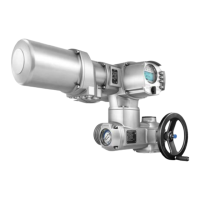●
Service lifts according to EN 81-1/A1
●
Escalators
●
Continuous duty
●
Buried service
●
Continuous submersion (observe enclosure protection)
●
Potentially explosive areas, with the exception of zone 22
●
Radiation exposed areas in nuclear power plants
No liability can be assumed for inappropriate or unintended use.
Observance of these operation instructions is considered as part of the device's
designated use.
Information
These operation instructions are only valid for the "clockwise closing" standard
version, i.e. driven shaft turns clockwise to close the valve.
1.3. Applications in Ex zone 22 (option)
Actuators of the indicated series basically meet the requirements for applications in
dust hazardous locations of ZONE 22 in compliance with the ATEX directive
2014/34/EU.
To comply with all requirements of the ATEX directive, observe the following points:
●
Actuators are marked with the explosion protection designation II3D... for use
in ZONE 22.
●
Maximum surface temperature of actuators
- T150 °C for ambient temperatures up to +60 °C or
- T190 °C for ambient temperatures up to +80 °C.
Increased dust deposit on the equipment was not considered for the determin-
ation of the maximum surface temperature.
●
The following conditions must be fulfilled to respect the maximum permissible
surface temperatures at the actuator:
- Respecting types of duty and technical manufacturer data
- Correct connection of thermal motor protection (thermoswitches or PTC
thermistor)
Table 1:
Maximum
surface temperature
Tripping temperature
Thermal motor protection
Ambient temperature
T150 °C140 °Cup to +60 °C
T190 °C155 °Cup to +80 °C
●
The connector may only be connected or disconnected when not live.
●
The cable glands and cable entries used have to meet the requirements of
category II3D and must at least comply with enclosure protection IP67.
●
The actuators must be connected by means of an external earth connection
(accessory part) to the equipotential earth bonding or integrated into an earthed
piping system.
●
To ensure combustible dust hazard protection, seal hollow shaft against ingress
of dust:
- Using threaded plug (ref. no. 511.0) and appropriate seal
- Using metallic stem protection tube, protective cap and V-seal (ref. no.
568.1, 568.2, 568.3) for rising valve stem
●
As a general rule, the requirements of IEC 60079 Parts 14 and 17 must be re-
spected in dust hazardous locations. During commissioning, service, and
maintenance, special care as well as qualified and trained personnel are required
for safe actuator operation.
6
SAV 07.2 – SAV 16.2 / SARV 07.2 – SARV 16.2 Control unit: electronic (MWG)
Safety instructions ACV 01.2 Modbus TCP/IP

